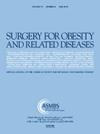Assessment of Obesity-related Metabolic Conditions: a novel objective scoring system better informs metabolic disease severity
IF 3.5
3区 医学
Q1 SURGERY
引用次数: 0
Abstract
Background
Reporting of obesity-associated metabolic disease severity and longitudinal response to bariatric surgery is not standardized. We updated our co-morbidity scoring tool to the Assessment of Obesity-related Metabolic Conditions (AOMC) to combine pharmacotherapy and biochemical data to score diabetes mellitus (DM), hypertension (HTN), and dyslipidemia (DYS) severity.
Objectives
The aim of this study is to determine whether the AOMC system more accurately stages metabolic disease severity than a clinically based Assessment of Obesity-Related Comorbidities (AORC) system.
Setting
University hospital, United States.
Methods
A retrospective cohort study of prospectively collected demographic, clinical, and biochemical data was performed on adults evaluated for bariatric surgery over 6 years. AORC versus AOMC scores and disease severity were compared using McNemar’s and Wilcoxon’s tests.
Results
Of 1442 patients, AOMC newly diagnosed metabolic disease in more patients than did AORC: DM (73.4% versus 44.5%), HTN (91.7% versus 67.9%), and DYS (63.8% versus 53.4%). Of those on pharmacotherapy, AOMC found fewer patients with adequately controlled disease: DM (39.9% versus 97.7%), HTN (64.7% versus 99.3%), and DYS (51.8% versus 99.0%). For those in whom both scores could be calculated, disease severity was upstaged in most patients: DM (65.9%), HTN (42.9%), and DYS (30.9%). There were also significant shifts toward higher scores for all conditions and severity classifications, with more patients diagnosed with pre–metabolic and severe disease (untreated/uncontrolled).
Conclusions
Our study demonstrated that the severity of DM, HTN, and DYS is vastly under-represented by clinical history alone and lacks standardized assessments. Our AOMC tool more accurately describes longitudinal metabolic response to bariatric surgery.
肥胖相关代谢疾病评估:一种新型客观评分系统能更好地反映代谢疾病的严重程度。
背景:肥胖相关代谢疾病严重程度和减肥手术纵向反应的报告尚未标准化。我们将合并疾病评分工具更新为肥胖相关代谢疾病评估(AOMC),结合药物治疗和生化数据对糖尿病(DM)、高血压(HTN)和血脂异常(DYS)的严重程度进行评分:本研究旨在确定 AOMC 系统是否比基于临床的肥胖相关并发症评估系统(AORC)更准确地分级代谢疾病的严重程度:地点:美国大学医院:方法:对前瞻性收集的人口、临床和生化数据进行回顾性队列研究,研究对象为接受减肥手术评估的成年人,时间跨度为 6 年。采用麦克尼马检验和威尔科克森检验比较了AORC和AOMC评分以及疾病严重程度:在1442名患者中,AOMC比AORC新诊断出更多代谢性疾病:糖尿病(73.4%对44.5%)、高血压(91.7%对67.9%)和DYS(63.8%对53.4%)。在接受药物治疗的患者中,AOMC发现病情得到充分控制的患者较少:DM(39.9%对97.7%)、HTN(64.7%对99.3%)和DYS(51.8%对99.0%)。在可以计算出这两项评分的患者中,大多数患者的疾病严重程度都有所升高:DM(65.9%)、HTN(42.9%)和 DYS(30.9%)。所有疾病和严重程度分类的得分也明显偏高,更多患者被诊断为代谢前疾病和严重疾病(未治疗/未控制):我们的研究表明,仅凭临床病史对糖尿病、高血压和慢性肾脏病严重程度的了解远远不够,而且缺乏标准化的评估。我们的AOMC工具能更准确地描述减肥手术的纵向代谢反应。
本文章由计算机程序翻译,如有差异,请以英文原文为准。
求助全文
约1分钟内获得全文
求助全文
来源期刊
CiteScore
6.70
自引率
12.90%
发文量
570
审稿时长
56 days
期刊介绍:
Surgery for Obesity and Related Diseases (SOARD), The Official Journal of the American Society for Metabolic and Bariatric Surgery (ASMBS) and the Brazilian Society for Bariatric Surgery, is an international journal devoted to the publication of peer-reviewed manuscripts of the highest quality with objective data regarding techniques for the treatment of severe obesity. Articles document the effects of surgically induced weight loss on obesity physiological, psychiatric and social co-morbidities.

 求助内容:
求助内容: 应助结果提醒方式:
应助结果提醒方式:


